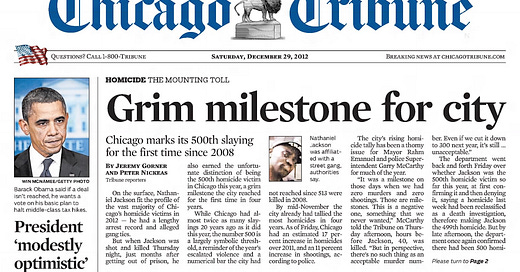Flashback: 'Grim milestone' 500
In the closing days of 2012, Chicago managed to notch its 500th homicide of the year. Something that today is common by September.
Coming out of the nineties and into the new millennium, the number of homicides fell along with the overall crime rate in Chicago. For the decade from the late aughts into the early teens, Chicago settled into a period of 450 homicides (+/- 10%) a year. Unlike recent history, posting a yearly tally of 500+ homicides was a rarity. One of those rarities was 2012:
Grim milestone for city
By Jeremy Gorner and Peter Nickeas
On the surface, Nathaniel Jackson fit the profile of the vast majority of Chicago's homicide victims in 2012 — he had a lengthy arrest record and alleged gang ties.
But when Jackson was shot and killed Thursday night, just months after getting out of prison, he also earned the unfortunate distinction of being the 500th homicide victim in Chicago this year, a grim milestone the city reached for the first time in four years.
While Chicago had almost twice as many slayings 20 years ago as it did this year, the number 500 is a largely symbolic threshold, a reminder of the year's escalated violence and a numerical bar the city had not reached since 513 were killed in 2008.
By mid-November the city already had tallied the most homicides in four years. As of Friday, Chicago had an estimated 17 percent increase in homicides over 2011, and an 11 percent increase in shootings, according to police.
After all the votes were tallied and enough murders could be forever classified as “death investigations”, Chicago officially ended 2012 with 514 murders (not homicides). Since we were still a few weeks out from going live and the Cook County Medical Examiner's (CCME) dataset doesn’t start until 2014, we do not know the true number of homicides, but it’s a sure bet it is more than a few bodies higher than 514.
The article continues with a quote from the one time Streetlight Assassin and former Supernintendo Gerry McCarthy…
"It was a milestone on those days when we had zero murders and zero shootings. Those are milestones. This is a negative one, something that we never wanted," McCarthy told the Tribune Thursday afternoon, hours before Jackson, 40, was killed. "But in perspective, there's no such thing as an acceptable murder number. Even if we cut it down to 300 next year, it's still … unacceptable."
unacceptable
adjective
not satisfactory; inadequate the standard was wholly unacceptable
intolerable every homicide is unacceptable
Unacceptable is a word that’s been uttered over and over ad nauseam. Despite the apparent unacceptability of these acts of violence, somehow Chicago still managed to rack up another 6,400 homicides and over 25,000 wounded since Mark Giangreco made a pass at anyone with a heartbeat, including Janet Davies, at midnight on Jan 1, 2013.
That’s a whole lot of acceptable for being unacceptable.
RIP Redeye
A quick historical note: during this time period, the Redeye of all publications kept track of homicides better than anyone. For those of you not old enough to remember the Redeye, it was a Tribune-owned daily tabloid handed out for free at L stops and elsewhere around town mainly covering pop culture and entertainment news.
In addition to restaurant reviews, upcoming concerts, and other topics aimed at the 20-something L rider, they kept a spreadsheet of all the homicides in Chicago based on the Cook County Medical Examiner’s data. This was a time before the CCME posted their data online, meaning Tracy and others called the ME every day (using a phone and talking to a human!) to get the latest information.
The Redeye stopped tracking homicides a couple of years later and ended its daily dead tree edition in 2017. Thankfully we have copies of the early spreadsheets somewhere.
Then vs Now
It should be noted that the Tribune articles used here help illustrate how far the corporate press has strayed over the years. Before yours truly, CWB, other alternative media and #chicagoscanner Twitter accounts came onto the scene, articles like these helped inform the reader with information, data, and quotes from the main players. They told a story. On the flip side, when it comes to today’s corporate media crime “reporting,” it is little more than copying and pasting the CPD’s official narratives and clicking “publish.”
We suppose that’s why we and others are here, to fill that gap between Ralph Wiggum and a Pulitzer Prize.
If you’ve made it this far, thanks for reading. Our goal is to push out one long form post a week in addition to our regular stats focused posts. Thanks and remember “We don't want nobody nobody sent”.







